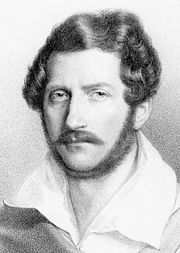압드 알함 ī드 이븐 튀르크
'Abd al-Hamīd ibn Turk이 문서 또는 섹션은 비영어 콘텐츠의 언어를 지정해야 하며, {{lang}}, {{transliteration}}, {{transliteration}}를 사용해야 합니다.IPA}}: 적절한 ISO 639 코드를 사용하여 음성 전사를 수행합니다. 위키피디아의 다국어 지원 템플릿도 사용할 수 있습니다.를 보세요. (2021년 5월) |
압둘함 î드 이븐 튀르크 | |
|---|---|
| 태어난 | 790 |
| 죽은 | 854 |
| 과학경력 | |
| 필드 | 수학 |
ʿ아브드 알함 ī드 이븐 ʿ드 이븐 와세 이븐 튀르크 질리 (아랍어: ابومحمد عبدالحمید بن واسع بن ترک الجیلی)로도 알려진 압드 알함 ī드 이븐 튀르크 (fl. 830)는 9세기 투르크계 이슬람 수학자였습니다. 그의 삶에 대해서는 알려진 것이 별로 없습니다. 이븐 나딤의 기록과 알 키프티의 기록이 일치하지 않습니다. 알퀴피는 그의 이름을 ʿ 압드 알함 ī드 이븐 와세 이븐 투르크 알질리라고 언급합니다. 질리는 길란에서 온 말입니다. 반면, 이븐 나딤은 자신의 니스바를 쿠탈리(ختلی)라고 언급하는데, 이는 옥수스의 북쪽과 바다흐샨의 서쪽에 위치한 지역입니다. 그의 알자브르와 알무카빌라의 남아있는 두 개의 필사본 중 하나에서, 그의 니스바에 대한 기록은 알질리에 더 가깝습니다.[2] 데이비드 핑그리 / 이란어 백과사전 이란어는 그가 원래 쿠탈이나 길란 출신이었다고 말합니다.[3] 그는 Al-Khwarzimi의 Al-Jabr와 매우 비슷하고 Al-Jabr과 비슷한 시기에, 혹은 심지어 Al-Jabr보다 더 일찍 출판된 대수학에 대한 연구를 썼습니다.[4] 2차 방정식의 해법에 관한 "혼합 방정식의 논리적 필요성"이라는 장만이 살아남았습니다. 원고는 Al-Jabr에서 발견되는 것과 정확히 동일한 기하학적 증명을 하고, 어떤 경우에는 Al-Jabr에서 발견되는 것과 동일한 예를 제시하며, 심지어 판별식이 음수이면 2차 방정식이 해가 없다는 기하학적 증명을 함으로써 Al-Jabr를 넘어서기도 합니다.[4] 이 두 작품 사이의 유사성 때문에 몇몇 역사학자들은 대수학이 알콰리즈미와 '압드 알하미드' 시대에 잘 발전했을 것이라고 결론지었습니다.[4]
참고문헌
- ^ "'Abd al-Hamid ibn Turk".
- ^ 이븐 튀르크 인 다 ʾ라트 알-마 ʿ라트-이 부주르그-이 이슬람 ī, 3권, 1001호, 테헤란. æ디아 이슬라마이카 백과사전에서 번역됩니다.
- ^ 핑리 1982, 페이지 111.
- ^ a b c Boyer, Carl B. (1991). "The Arabic Hegemony". A History of Mathematics (Second ed.). John Wiley & Sons, Inc. p. 234. ISBN 0-471-54397-7.
The Algebra of al-Khwarizmi usually is regarded as the first work on the subject, but a recent publication in Turkey raises some questions about this. A manuscript of a work by 'Abd-al-Hamid ibn-Turk, entitled "Logical Necessities in Mixed Equations," was part of a book on Al-jabr wa'l muqabalah which was evidently very much the same as that by al-Khwarizmi and was published at about the same time – possibly even earlier. The surviving chapters on "Logical Necessities" give precisely the same type of geometric demonstration as al-Khwarizmi's Algebra and in one case the same illustrative example x2 + 21 = 10x. In one respect 'Abd-al-Hamad's exposition is more thorough than that of al-Khwarizmi for he gives geometric figures to prove that if the discriminant is negative, a quadratic equation has no solution. Similarities in the works of the two men and the systematic organization found in them seem to indicate that algebra in their day was not so recent a development as has usually been assumed. When textbooks with a conventional and well-ordered exposition appear simultaneously, a subject is likely to be considerably beyond the formative stage. ... Note the omission of Diophantus and Pappus, authors who evidently were not at first known in Arabia, although the Diophantine Arithmetica became familiar before the end of the tenth century.
더보기
- Høyrup, J. (1986). "Al-Khwarizmi, Ibn Turk and the Liber Mensurationum: On the Origins of Islamic Algebra". Erdem. 5 (5): 445–484. doi:10.32704/erdem.1986.5.445. S2CID 126060042.
- Pingree, David (1982). "ʿABD-AL-ḤAMĪD B. VĀSEʿ". Encyclopaedia Iranica, Vol. I, Fasc. 1. p. 111.
- Sayili, Aydin (1962). Abdülhamit İbn Türk'ün Katışık Denklemlerde Mantıki Zaruretler Adlı Yazısı ve Zamanın Cebri. (Logical necessities in mixed equations by ʿAbd al Hamīd ibn Turk and the algebra of his time.). Ankara: Türk Tarih Kurumu Basımevı. '리뷰 히스트'의 장 이타르드 목사. Sci. Application, 1965, I8:123-124.
외부 링크
- Pingree, David. "ʿABD-AL-ḤAMĪD B. VĀSEʿ". www.iranicaonline.org. Encyclopaedia Iranica.



